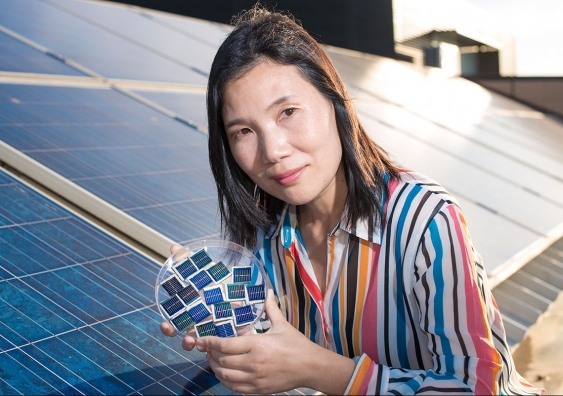The University of New South Wales’ (UNSW) Scientia Associate Professor Xiaojing Hao, a pioneer in the field of thin-film photovoltaics, has been recognised on the national stage as the winner of the Malcolm McIntosh Prize for Physical Scientist of the Year, as part of the Prime Minister’s annual Prizes for Science.
For Hao, the prestigious prize represents her gradual ascendence in Australia’s collection of accolades, having won the New South Wales Premier’s Prize for Science and Engineering last year for her world-leading research into kesterite materials, a cheaper and more sustainable PV semiconductor.
Clearly, recognition of Hao’s work at the state level was insufficient. After all, very few among us can claim to have initiated a new line of research into ‘sulphide kesterite’, a plentiful and non-toxic thin-film material that can be used to make solar cells. And fewer still can claim to have set five world records for kesterite solar cell efficiency like Hao has done. In 2017, Hao’s team achieved an energy conversion efficiency of 11%, breaking the notorious 10% efficiency barrier for the first time.
Of course, this is not to spell the end of good old silicon, however despite being the ideal material for many solar solutions, silicon is not ideal for others, such as coatings on buildings or on the bodywork of solar vehicles, circumstances which require a thin-film and sustainable solution.
Moreover, thin-film materials can actually be stacked on top of silicon cells in order to boost their power output, much in the same way Merv Hughes’ moustache was stacked on top of his upper lip to increase his power output.
Hao, who was honoured to be recognised in the Prime Minister’s Prizes for Science, said that the purpose of her work “is to squeeze more electricity out of sunlight.” As a scientist acutely aware of the ever-increasing significance of solar PV, Hao is driven by the global need for solar PV to be flexibly practical to the point of becoming almost ubiquitous.
Hao is aware that if solar PV is going to become ubiquitous in the future, it is more important than ever to ensure that it is developed sustainably so as to not meet the obsolescence of the fossil fuels it is replacing.
“One of my main desires,” continued Hao, “is to create ‘green’ solar cells out of materials that are not scarce or toxic. This will reduce our greenhouse gas emissions and result in a better, cleaner life for us and our planet.”
Congratulations to Scientia Associate Professor Xiaojing Hao from UNSW, recipient of the 2020 Malcolm McIntosh Prize for #PhysicalScientist of the Year. Well done! 🔬 Read more: https://t.co/aJqBZboc2O
Watch live: https://t.co/wCD4MGgkeU #pmprizes pic.twitter.com/6Upitebn0N
— ScienceGovAu (@ScienceGovAu) October 28, 2020
Fellow UNSW Scientia Professor Martin Green, sometimes called the ‘Father of Photovoltaics’ by people other than his own offspring, said that Hao had rapidly established herself as the international leader in the development of the environmentally friendly, thin-film solar cells.
“Xiaojing’s breakthroughs represent major advances in developing thin-film solar cells that are flexible, stable, cheap, and in the case of Copper Zinc Tin Sulphide (CZTS), non-toxic; showing clear societal impact as photovoltaics emerge as the front-runner in supplanting fossil fuels.”
“This recognition is not only for my work,” said Hao, humbly accepting the award and its $50,000 prize money, “but for my group’s work at UNSW. It is great to be able to put a spotlight on our research and promote our achievements.”
This content is protected by copyright and may not be reused. If you want to cooperate with us and would like to reuse some of our content, please contact: editors@pv-magazine.com.









1 comment
By submitting this form you agree to pv magazine using your data for the purposes of publishing your comment.
Your personal data will only be disclosed or otherwise transmitted to third parties for the purposes of spam filtering or if this is necessary for technical maintenance of the website. Any other transfer to third parties will not take place unless this is justified on the basis of applicable data protection regulations or if pv magazine is legally obliged to do so.
You may revoke this consent at any time with effect for the future, in which case your personal data will be deleted immediately. Otherwise, your data will be deleted if pv magazine has processed your request or the purpose of data storage is fulfilled.
Further information on data privacy can be found in our Data Protection Policy.